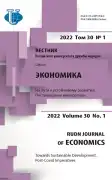Trade strategy of European Union and the impact of EU-South Korea FTA
- Autores: Woosik Y.1, Han-Sol L.2
-
Afiliações:
- Seoul National University
- Peoples’ Friendship University of Russia (RUDN University)
- Edição: Volume 30, Nº 1 (2022): TOWARDS SUSTAINABLE DEVELOPMENT. POST-COVID IMPERATIVES
- Páginas: 70-78
- Seção: Economic integration and globalization
- URL: https://journal-vniispk.ru/2313-2329/article/view/324199
- DOI: https://doi.org/10.22363/2313-2329-2022-30-1-70-78
- ID: 324199
Citar
Texto integral
Resumo
When the global financial erupted, European Union (EU) had suffered from unprecedented economic downturn. Unemployment soared and consumption declined, causing negative effects on Europe’s per capita income growth. EU then started to realize the need for the utilization of Free Trade Agreements (FTAs), to alleviate the low growth trend of European economy. As the first initiative of EU Global Strategy, which was intended to significantly expand EU’s export markets to offshore countries through FTAs, South Korea was selected as one of the first targets. After eight rounds of FTA negotiations started from 2006, FTA between EU and South Korea came into effect in 2011. Using UN Comtrade’s export and import data from 2000 to 2017, this paper discusses about changes in trade patterns of EU and South Korea before and after the EU-South Korea FTA, and empirically analyzes the impact of EU-South Korea FTA. The results of our regression models show that the FTA indeed has positive effects on growth of both trade volume and trade share in the world, between South Korea and the EU, with significance. The fact that there were increases not only in commodity trade, but also in service goods trade and foreign direct investment suggests that the virtuous cycle of EU-South Korea FTA can expand to related areas. Furthermore, as South Korea is East Asia’s FTA-centered country which signed FTAs with both US and China, the two largest economies in the world, the indirect benefits from the EU-South Korea FTA will become greater for the EU. This advantage is expected to help creating a virtuous cycle that induces economic growth of EU through increases in trade, productivity, and job creation.
Palavras-chave
Sobre autores
Yu Woosik
Seoul National University
Email: woosik@snu.ac.kr
ORCID ID: 0000-0001-8261-6842
Research Associate, Center for International Development Studies, Institute of International Affairs, Graduate School of International Studies
1 Gwanak-ro, Gwanak-gu, Seoul, 08826, Republic of KoreaLee Han-Sol
Peoples’ Friendship University of Russia (RUDN University)
Autor responsável pela correspondência
Email: 1042185141@pfur.ru
ORCID ID: 0000-0002-7846-2374
Senior Lecturer, Marketing Department
6 Miklukho-Maklaya St, Moscow, 117198, Russian FederationBibliografia
- Augier, P., Gasiorek, M., & Lai Tong, C. (2005). The impact of rules of Origin on Trade Flows. Economic Policy, 20(43), 568-624. https://doi.org/10.1111/j.1468-0327.2005.00146.x
- Business Europe (2007). Position paper on the EU-South Korea Free Trade Agreement.
- Busse, M., Gröning, S., & Groening, S. (2012). Assessing the impact of trade liberalization: The case of Jordan. Journal of Economic Integration, 466-486.
- Duong, N.B. (2016). Vietnam-EU Free Trade agreement: impact and policy implications for Vietnam. SECO/WTI Academic Cooperation Project Working Paper Series, 7.
- European Union (2015). Trade for all. Retrieved June 20, 2019, from http://trade.ec.europa.eu/doclib/docs/2016/august/tradoc_154919.pdf
- European Union (2016). Assessing Results of the EU-South Korea Free Trade Agreement. Retrieved June 20, 2019, from https://eeas.europa.eu/sites/eeas/files/eu-rok_fta_results_handbook_en.pdf
- European Union (2012). Consolidated version of the treaty on European Union. Official Journal of the European Union.
- Eurostat. Retrieved June 20, 2019, from http://ec.europa.eu/eurostat
- Francis, S. (2011). The ASEAN-India Free Trade Agreement: A sectoral impact analysis of increased trade integration in goods. Economic and Political Weekly, 46(2), 46-55.
- Jang, Y.J. (2011). The impact of bilateral free trade agreements on bilateral foreign direct investment among developed countries. The World Economy, 34(9), 1628-1651.
- Kang, Y-D., Lee, C-W., Lee, H., & Oh, H. (2011). Korea’s trade policy and strategy toward the EU after Korea-EU FTA, Policy Analysis. Korea Institute for International Economic Policy (KIEP), 11-10. (In Korean)
- Korean Ministry of Foreign Affairs, Korea-EU Free Trade Agreement. Retrieved June 20, 2019, from http://fta.go.kr/eu. (In Korean)
- Oh, W.K., & Lee, S.Y.T. (2011). The Impact of FTA on ICT industries: The case of the Korea-US FTA. Asia-Pacific Journal of EU Studies, 9(2), 51-64.
- Okabe, M. (2015). Impact of free trade agreements on trade in East Asia. ERIA Discussion Paper Series, (1), 48.
- Quimba, F.M.A., Barral, M.A.A., Rosellon, M.A.D., & Сalizo Jr, S.C. (2020). Impact of FTA on Philippine Industries: Analysis of Network Effects, 44.
- Thangavelu, S.M., Narjoko, D., & Urata, S. (2021). Impact of FTA on trade in ASEAN and Australia using customs level data. Journal of Economic Integration, 36(3), 437-461.
- Xiang, H., Kuang, Y., & Li, C. (2017). Impact of the China-Australia FTA on global coal production and trade. Journal of Policy Modeling, 39(1), 65-78.
Arquivos suplementares









